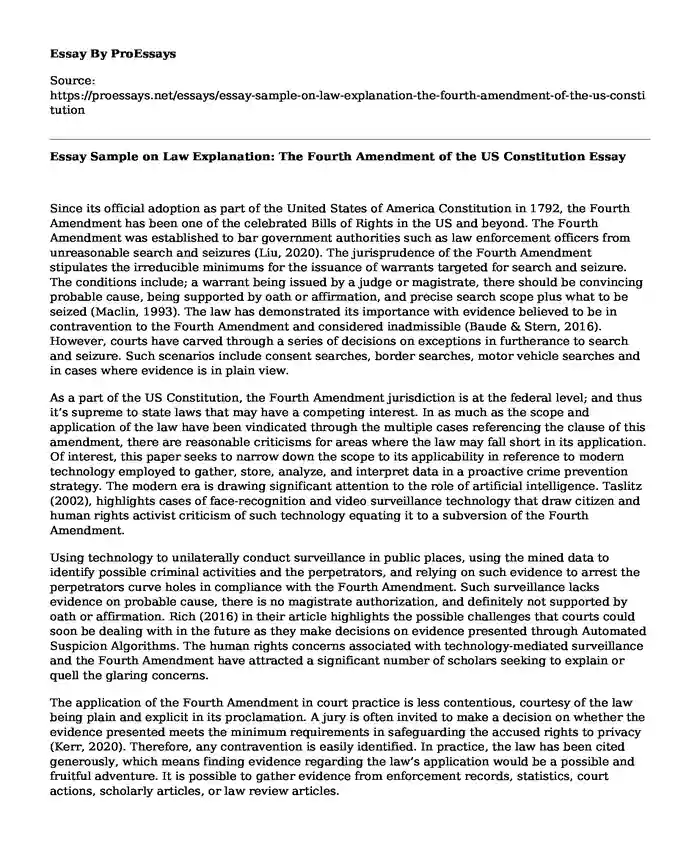Since its official adoption as part of the United States of America Constitution in 1792, the Fourth Amendment has been one of the celebrated Bills of Rights in the US and beyond. The Fourth Amendment was established to bar government authorities such as law enforcement officers from unreasonable search and seizures (Liu, 2020). The jurisprudence of the Fourth Amendment stipulates the irreducible minimums for the issuance of warrants targeted for search and seizure. The conditions include; a warrant being issued by a judge or magistrate, there should be convincing probable cause, being supported by oath or affirmation, and precise search scope plus what to be seized (Maclin, 1993). The law has demonstrated its importance with evidence believed to be in contravention to the Fourth Amendment and considered inadmissible (Baude & Stern, 2016). However, courts have carved through a series of decisions on exceptions in furtherance to search and seizure. Such scenarios include consent searches, border searches, motor vehicle searches and in cases where evidence is in plain view.
As a part of the US Constitution, the Fourth Amendment jurisdiction is at the federal level; and thus it’s supreme to state laws that may have a competing interest. In as much as the scope and application of the law have been vindicated through the multiple cases referencing the clause of this amendment, there are reasonable criticisms for areas where the law may fall short in its application. Of interest, this paper seeks to narrow down the scope to its applicability in reference to modern technology employed to gather, store, analyze, and interpret data in a proactive crime prevention strategy. The modern era is drawing significant attention to the role of artificial intelligence. Taslitz (2002), highlights cases of face-recognition and video surveillance technology that draw citizen and human rights activist criticism of such technology equating it to a subversion of the Fourth Amendment.
Using technology to unilaterally conduct surveillance in public places, using the mined data to identify possible criminal activities and the perpetrators, and relying on such evidence to arrest the perpetrators curve holes in compliance with the Fourth Amendment. Such surveillance lacks evidence on probable cause, there is no magistrate authorization, and definitely not supported by oath or affirmation. Rich (2016) in their article highlights the possible challenges that courts could soon be dealing with in the future as they make decisions on evidence presented through Automated Suspicion Algorithms. The human rights concerns associated with technology-mediated surveillance and the Fourth Amendment have attracted a significant number of scholars seeking to explain or quell the glaring concerns.
The application of the Fourth Amendment in court practice is less contentious, courtesy of the law being plain and explicit in its proclamation. A jury is often invited to make a decision on whether the evidence presented meets the minimum requirements in safeguarding the accused rights to privacy (Kerr, 2020). Therefore, any contravention is easily identified. In practice, the law has been cited generously, which means finding evidence regarding the law’s application would be a possible and fruitful adventure. It is possible to gather evidence from enforcement records, statistics, court actions, scholarly articles, or law review articles.
Conclusion
In conclusion, the Fourth Amendment law has been demonstrated to work in safeguarding human rights as far as privacy related to search and seizure is concerned. However, with technological advancement and the adoption of artificial technology, there could be challenges in admitting or presenting evidence acquired through what could be considered intrusive means and not in compliance with the law.
References
Baude, W. & Stern, J.Y. (2016). The positive law model of the fourth amendment. Harvard Law Review. 129(7); 1821 – 1889 https://scholarship.law.wm.edu/facpubs/1808
Kerr, O.S. (2020). The questionable objectivity of Fourth Amendment Law. Texas Law Review, https://ssrn.com/abstract=3651475Liu, J. (2020). A pragmatic study: The Fourth Amendment. Journal of Chinese Philosophy, 1(1); 1 – 21. https://doi.org/10.1111/1540-6253.12404
Maclin, T. (1993). The central meaning of the Fourth Amendment. William & Mary Law Review 35(197); 212-216. https://scholarship.law.wm.edu/wmlr/vol35/iss1/7
Rich, M.L. (2016). Machine learning, automated suspicion algorithms, and the Fourth Amendment. University of Pennsylvania Law Review, 164(4); 871 – 929. https://www.jstor.org/stable/24753528
Taslitz, A.E. (2002). The Fourth Amendment in the twenty-first century: technology, privacy, and human emotions. Law and Contemporary Problems, 65(2); 125 – 187. https://www.jstor.org/stable/1192242
Cite this page
Essay Sample on Law Explanation: The Fourth Amendment of the US Constitution. (2023, Dec 16). Retrieved from https://proessays.net/essays/essay-sample-on-law-explanation-the-fourth-amendment-of-the-us-constitution
If you are the original author of this essay and no longer wish to have it published on the ProEssays website, please click below to request its removal:
- Research Paper on Comparison of the 2000 And 2004 Democratic National Convention Security Plan
- The Republican Experiment 1783-1789 Essay
- Essay Sample on UK as Free & Secure Haven for Immigrants & Asylum Seekers
- Union Discriminates Female Police Inspector, Chief Massey Alerts Colleagues - Essay Sample
- Essay Sample on Internet Privacy: A Growing Global Concern?
- Research Paper on U.S. Gun Export & Gun Violence: A Growing Threat
- Harnessing Energy From Fossil Fuels, Wind & Solar Power - Essay Sample







